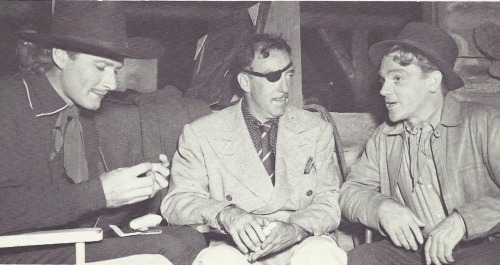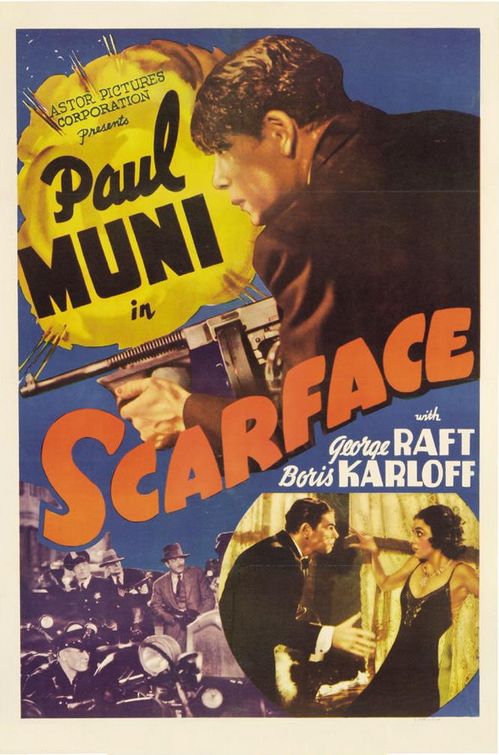 Dir: Raoul Walsh
Dir: Raoul WalshStarring: James Cagney, Humphrey Bogart, Priscilla Lane
Country: USA
B&W
Under the studio system in Hollywood pretty much all films fitted into a genre. Some of the best known are: horror, western, musical, screwball comedy, melodrama and of course the gangster film.
In any business, when a product is successful, more are made to capitalise on the success of the first product. The film business (as is still sadly the case) is no exception to this.
The downside is that over time the quality that was inherent in the first product, will eventually diminish. The upside is, that for a moment, before an idea is rinsed out, the product will be unparalleled. Consequently, when studios got good at making a certain kind of film (and we must remember that stars were contracted to exclusive deals with one studio), they became known for it; it was their specialty.
- MGM became know for musicals because it did glamour and gloss so well.
- Universal were unrivaled in horror movie production in the 1930's.
- Everybody made westerns.
- And Warner Brother made gangster pictures.
Before The Godfather; before Goodfellas; before Carlito's Way and before Scarface there was Public Enemy, Angels With Dirty Faces and The Roaring Twenties. Scarface itself is a remake of a 1932 film.
The Warner Brothers cycle of gangster movies from the 1930's, probably more than any other moment in cinema history, came to define a key moment in American history.
 The Volstead Act (1919-1933) prohibited the sale of alcohol across the US, however the demand for alcohol did not miraculously disappear. Into the void stepped a motley crew of mostly Irish, Jewish and Italian gangs intent on getting rich. Initially they imported booze illegally; running it over the border from Canada (it is from this period we get the term "bootlegger") and selling it in speak easies. But eventually they began distilling their own variations on alcoholic drinks, which maximized profits but did put the health of the punters at risk.
The Volstead Act (1919-1933) prohibited the sale of alcohol across the US, however the demand for alcohol did not miraculously disappear. Into the void stepped a motley crew of mostly Irish, Jewish and Italian gangs intent on getting rich. Initially they imported booze illegally; running it over the border from Canada (it is from this period we get the term "bootlegger") and selling it in speak easies. But eventually they began distilling their own variations on alcoholic drinks, which maximized profits but did put the health of the punters at risk.As the gangs grew in wealth and power they began to engage in turf wars with each other as they all vied for control of the liquor trade. By the time prohibition was repealed, the criminal make-up of America had been transformed.
The Italians emerged the ultimate victors and it is from this time that the Mafia, as we now know it, really begins to take shape as an organised criminal network with an infrastructure of families with soldiers, captains, under-bosses, bosses and at the very top, the boss of bosses, or Capo di tutti capi, as it is in Italian.
However, since much of this activity took place in New York, and the Irish were the first immigrants to really make their mark there, in the early days of prohibition a lot of the gangs were Irish. They emerged from the street gangs that formed in New York in the 19th century (See Martin Scorsese's Gangs of New York) and would go on to be so influential in the police force and politics - JFK's father Joe Kennedy, was known to have been a bootlegger.
But perhaps just as importantly Warner Brothers had James Cagney under contract, and he was never going to play an Italian.
The 1930s belong to Jimmy Cagney. One of the greatest screen actors of all time, he managed to combine a sometimes quite theatrical exuberance, with a street sensibility that made him mesmerizing to watch. You literally did not know what Cagney would do next.
 |
| Cagney as Tom Powers at the climax of Public Enemy |
By 1939 Cagney was already a huge star and Warner Brothers had gotten the gangster picture down to a fine art, though in doing so they had become somewhat stale. However, were the lead characters in gangster films prior to this had frequently been thinly veiled references to real gangsters, The Roaring Twenties was based on a story by Mark Hellinnger, who had been a crime reporter in New York during this momentous, tumultuous time.
 |
| Edward G. Robinson as Rico in Little Caesar |
His story of an ex-soldier, turned bootlegger, turned crime boss, offered a plausible rags to riches story for the modern era. The evolution of Jimmy Cagney's everyman car mechanic, Eddie Bartlett to a powerful gangster both shocked and thrilled; its ripped-straight-from-the-headlines ring of truth, gave the audience a three dimensional protagonist, which had not quite been achieved in Little Caesar or Scarface - both based on Al Capone.
Alongside Cagney starred Humphrey Bogart, still yet to make the grade as a leading man and confined mostly to "bad man" roles, at which he was nonetheless very effective. Bogart's real break wouldn't come for another year, when in a rather short-sighted move, George Raft turned down the role of Sam Spade in John Huston's adaptation of Dashiel Hammet's The Maltese Falcon (1941). The film made Bogart and Raft's career sadly went into perpetual decline.
 |
| Al Capone, the original Scarface |
The gangster genre is unique to American cinema. The British have attempted it but, with a few rare exceptions, the results tend to be weak at best.
The American gangster in many ways reflects the dark underbelly of the American Dream. The fact that the majority of gangsters rise from immigrant communities, who have gone to America to pursue the dream, is no accident. Whether Irish, Italian or Jewish, the immigrants quickly realised that they were second class citizens in America, especially those that chose to remain in the cities and not break out for the wide open spaces of the frontier.
 |
| "He used to be a big shot". Eddie Bartlett's death draws an explicit link between the gangster's downfall and the sacrifice of Christ |
The Roaring Twenties, like many gangster films, is a "rise and fall" story. What distinguishes it from the others, for me, is Cagney's portrayal Eddie Bartlett, as a reluctant hoodlum, constrained by circumstance. His inevitable downfall therefore feels less a comeuppance, and more a tragedy - emphasised by the final pieta on the steps of the cathedral, a clear religious metaphor, linking Bartlett's demise to ideas of suffering and sacrifice. This was a new grace note for the gangster film, something earlier attempted in Angels with Dirty Faces (1938).
Previously they purported to be staunchly moralistic stories; cautionary tales about the dangers of greed and violence. But the vicarious thrills offered by gangster movies were hugely appealing to the public. Like the cowboy heroes of westerns, here was a man who lived by his own rules, didn't take orders from anyone and followed his own (albeit rather loose) moral code. The films themselves thrilled 30's audiences who, still reeling from the depression, identified with the an anti-hero who robbed from big business and gave the public what they wanted; illegal liquor.
 |
| From left to right: Errol Flynn, tough guy director Raoul Walsh and Cagney |
A mood of reckless abandon had pervaded America in the 1920's and the gangster film captured it perfectly. But perhaps The Roaring Twenties was the first film to really attempt to examine what was still very recent history and offer some kind of commentary on the period.
Eddie Bartlett is ultimately seduced by the bright lights and glamour of the world that is foisted upon him, before falling victim to the Wall Street Crash and becoming one of millions ruined by the financial collapse that followed. It is in the film's attempt to honestly appraise the impact of this tumultuous decade on ordinary people, that I think enables The Roaring Twenties to transcend the confines of its genre, and allows it to still feel vital and enthralling to this day; one of the first truly modern films.



No comments:
Post a Comment